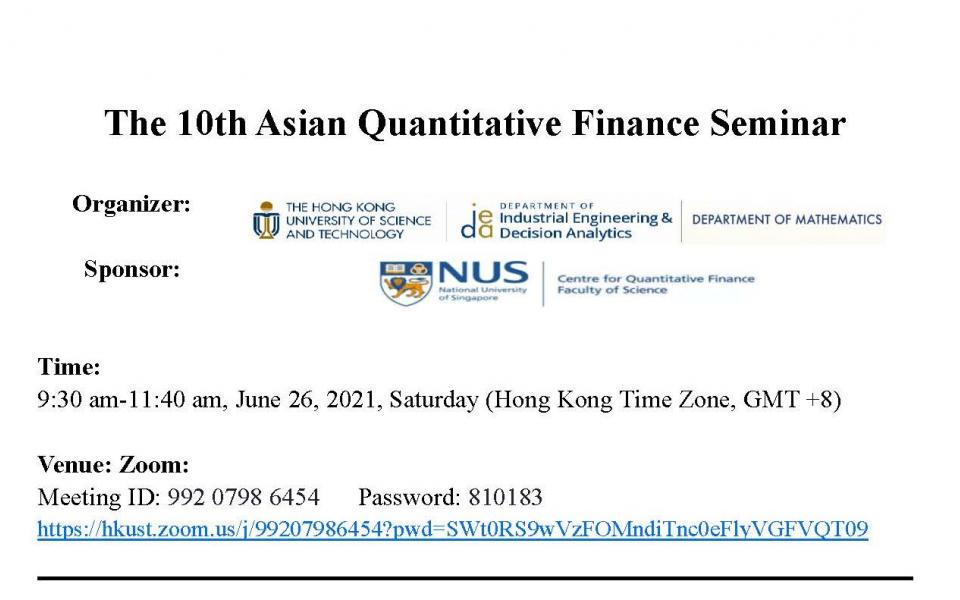The 10th Asian Quantitative Finance Seminar (AQFS)
Supporting the below United Nations Sustainable Development Goals:支持以下聯合國可持續發展目標:支持以下联合国可持续发展目标:
Optimal Time-Consistent Debt Policies ~ Andrey Malenko, University of Michigan Anton Tsoy, University of Toronto
Abstract: We study time-consistent debt policies in a trade-off model of debt in which the firm can freely issue new debt and repurchase existing debt. A debt policy is timeconsistent if in any state equity-holders prefer to follow it rather than to deviate from it but lose credibility in sustaining debt discipline in the future. In a class of policies, the optimal time-consistent debt policy consists of an interest coverage ratio (ICR) target and two regions for the ICR: the stable and the distress regions. In the stable region, the firm actively manages liabilities to the ICR target by issuing/repurchasing debt. A sufficiently large negative shock to cash flows pushes the firm into the distress region, where it abandons the target and waits until either cash flows recover or further negative shocks trigger bankruptcy. Credit spreads are sensitive to cash flow shocks in the distress region but not in the stable region. The optimal policy captures realistic features of debt dynamics, such as active debt management in both directions, interior optimal debt maturity, and dynamics of “fallen angels.”
Bio: Prof. Andrey Malenko is an Associate Professor of Finance at the University of Michigan’s Ross School of Business. His research is in the area of corporate investment and financing, corporate governance, mergers and acquisitions, as well as auction theory and economics of information. His work has been published in leading academic journals, such as American Economic Review, Review of Economic Studies, Journal of Finance, Journal of Financial Economics, and Review of Financial Studies. He is the recipient of the 2020 Brattle Prize for a distinguished paper in corporate finance in the Journal of Finance. He is a Research Fellow of Centre for Economic Policy and Research, and an Associate Editor at the Journal of Finance, Management Science, Review of Finance, and Review of Corporate Financial Studies. Before joining Michigan Ross, he was on the faculty of MIT Sloan School Management and Boston College’s Carroll School of Management. Professor Malenko received a Ph.D. in Finance in 2011 from Stanford Graduate School of Business, and Master and Bachelor’s degrees from New Economic School and NRU – Higher School of Economics in Moscow, Russia. He currently teaches MBA and Ph.D. courses in Corporate Financial Policy and Finance Theory.
On ambiguity-seeking behavior in finance models with smooth ambiguity ~ Dmitry Makarov, HSE University, Russia
Abstract: Ambiguity-seeking behavior is universally disregarded in a large theoretical finance literature with smooth ambiguity preferences. This paper questions the three rationales for this practice. First, smooth ambiguity models are not ill-defined under ambiguity-seeking. Second, a representative investor need not be ambiguity-averse when an average individual trader is ambiguity-averse. Third, individual traders need
not be ambiguity-averse when a representative investor is ambiguity-averse. Our constructive suggestion is that researchers should calculate the allowed levels of ambiguity-seeking for which their model is well-posed, and then let the data speak for themselves whether ambiguity-seeking or ambiguity-aversion can better explain empirical evidence.
Testing the Local Martingale Theory of Bubble using Cryptocurrencies ~ Soon Hyeok Choi, Cornell University Robert Jarrow, Cornell University
Abstract: Cryptocurrencies provide the ideal and natural experimental setting to test the local martingale theory of bubbles, because they have no cash flows. Using this theory, we test for the existence of price bubbles in eight cryptocurrencies from January 1, 2019 to July 17, 2019. The cryptocurrencies are Bitcoin (BTC), Litecoin (LTC), Ethereum (ETH), Ripple (XRP), Bitcoin Cash (BCH), EOS (EOS), Monero (XMR), and Zcash (ZEC). A novel, simple, and robust testing methodology is created to facilitate this estimation. During this time frame, five of the eight currencies (BTC, BCH, EOS, XMR, ZEC) exhibit price bubbles, Litecoin does not, and the evidence for Ethereum and Ripple is inconclusive. The paper provides strong evidence for the prevalence of bubbles in cryptocurrencies and supports the feasibility of applying the local martingale theory of bubbles to various asset classes.
Zoom
https://hkust.zoom.us/j/99207986454?pwd=SWt0RS9wVzFOMndiTnc0eFlyVGFVQT09
Meeting ID: 992 0798 6454
Password: 810183
